

Don't fall victim to the dreaded Ttwwadi! Smashing Silos! Photo credit: iStockPhoto We love to organize things into boxes: black or white; red state or blue state; mustard or ketchup.

We like to categorize subject matter, too, and teach it in discrete bits. We silo subjects. In one class period we teach one subject, followed by another subject in the following period. While subjects might be taught by the same teacher and in the same space, we never see their connections. Training Wheels This teaching approach of simplification-by-isolation was created to make complex concepts more manageable. Siloed subjects help schools, but they really don't help our students. A Learning Watering Hole One question you might have is: "How do you apply these new ways of teaching to the standards? " Let's provide children an opportunity to exercise their brains on broad and complex topics, and to look at the linkages.
Water can be a means to teach global topics. Notes. Project Tomorrow. Six laws of tech adoption (part 3 of 7) Oct 28 Written by: 10/28/2013 7:31 AM By Gary Shattuck, CIO Advisor In my last blog, I began explaining the first of what I call the Six Laws of Technology Adoption in Education.
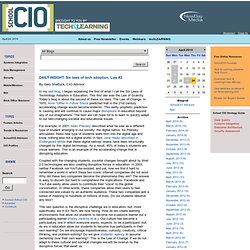
This first law was the Law of Scarcity. Today’s blog is about the second of these six laws: The Law of Change. For example, in 2001, Marc Prensky described what he saw as a different type of student emerging in our society: the digital native. Coupled with the changing students, societal changes brought about by Web 2.0 technologies are also creating disruptive forces in education. A Survival Guide To Teaching With Technology. If you’re a brave soul attempting to teach with technology, then you know that it can be a challenging and downright difficult task.
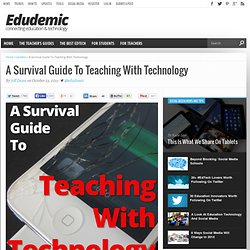
Students are resistant to change. Teachers are too. Administrators are, well, too. Everyone seems to be unsure about how to effectively integrate technology without running into several roadblocks. A presentation by the always amazing Shelly Terrell should help. (sometimes you need to refresh this page to view the presentation – not sure why) The presentation above walks you through (step-by-step – love that show – now the theme song is in my head) how to approach technology integration. The next step is to simply understand that technology is a tool. Now get connected. 24 Ed-Tech Terms You Should Know. The Teacher's Guides To Technology And Learning. Welcome to the official guide to technology and learning by Edudemic!

This part of Edudemic is meant to offer you, the teacher, some of the best and most popular resources available today. We’ve combed through hundreds of resources in order to narrow down our guides into something easy to read, easy to use, and easy to share. Below are links to the guides we have made so far. They’re always a work in progress so be sure to let us know if we missed something or if you have more resources you want us to call out in the guides.
The 20 Best Pinterest Boards About Education Technology. Pinterest is quickly becoming one of the biggest sources inspiration and innovation when it comes to cooking, design, and education. That’s right, education is a prominent fixture on Pinterest now and that, of course, means that education technology plays a starring role. In an effort to help curate the massive amount of Pinterest boards about education technology, you can use the following list as a jumping off point to start your Pinterest journey. The following boards are curated by teachers, admins, and other education enthusiasts. Blogs on Technology Integration. In part one of this series, I shared how I use freely available video in my reading and literacy methods course to help my preservice teachers understand close reading instruction at a level that could not be attained through reading and discussion alone.
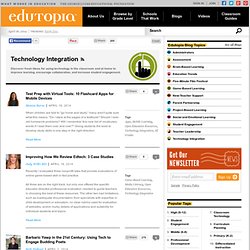
In part two, I shared my curated collection of videos for general Common Core info, as well as videos to teach the close reading, text complexity and informational texts standards. Below is my curated collection of videos of exceptional professional websites for reading teachers that feature videos and resources on word generation, explicit instruction, graphic organizers and text difficulty, among other topics. How Can Teachers Create a Learner-Centered Environment? - Leading From the Classroom. Ed Chat Radio. Edu Vue. The 21st century pedagogy teachers should be aware of. Interpersonal learning , personalized learning, second life learning , 3d learning, collaborative learning and virtual learning , these are just some of the few buzz words you would be be reading so often in today’s educational literature.

Things have changed , old methods and pedagogies are no longer relevant. The teacher-controlled learning where pre-constructed information is presented in a formal and standardized classroom settings becomes very obsolete. The urgent questions we should , as educators , ask ourselves are : what are the driving factors behind this huge transformation in learning ?
The Partnership for 21st Century Skills. WayFind Teacher Assessment for Effective 21st Century Teachers. Valid Data, Rigorously Tested WayFind has gone through a rigorous beta testing, and third-party psychometric review to ensure the data is accurate, meaningful, and reliable.
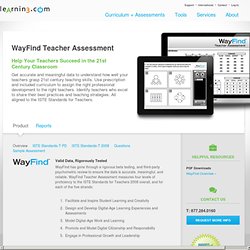
WayFind Teacher Assessment measures four levels of proficiency to the ISTE Standards for Teachers 2008 overall, and for each of the five strands: Facilitate and Inspire Student Learning and Creativity Design and Develop Digital-Age Learning Experiences and Assessments Model Digital-Age Work and Learning Promote and Model Digital Citizenship and Responsibility Engage in Professional Growth and Leadership. How we will learn. MindShift explores the future of learning in all its dimensions.
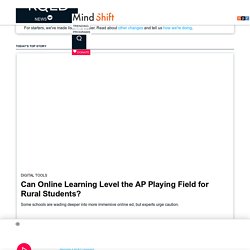
We examine how learning is being impacted by technology, discoveries about how the brain works, poverty and inequities, social and emotional practices, assessments, digital games, design thinking and music, among many other topics. We look at how learning is evolving in the classroom and beyond.We also revisit old ideas that have come full circle in the era of the over scheduled child, such as unschooling, tinkering, playing in the woods, mindfulness, inquiry-based learning and student motivation.
We report on shifts in how educators practice their craft as they apply innovative ideas to help students learn, while meeting the rigorous demands of their standards and curriculum. Computer Literacy. Sometimes it's just not about the shiny new stuff... #EdChat Radio by BAM Radio Network -The Twitterati Channel. The 21st Century Learning and Teaching Skills You should not Miss. Digital media and internet are transforming the way our kids socialize and play; they are even changing the way they learn and participate civically.
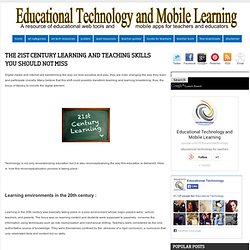
Many believe that this shift could possibly transform teaching and learning broadening, thus, the focus of literacy to include the digital element. Technology is not only revolutionizing education but it is also reconceptualizing the way this education is delivered. What’s the Difference Between “Using Technology” and “Technology Integration”?